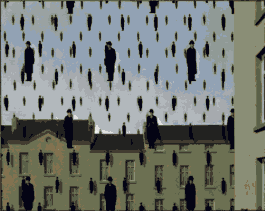Math 361 - Chaos and Dynamical Systems
Spring Semester, 2007-2008
Go straight to the syllabus.


This course is about dynamics--the mathematics of how things change
with time. Dynamics has evolved from its origins in the calculus of Newton
and Leibniz to a modern theory of dynamical systems relevant to areas of
science including physics, astronomy, biology, chemistry, engineering,
medicine, ecology, and economics. We will look at the main concepts and
applications of dynamical systems and, in particular, a type of motion
now called "chaos".

CLASS INFORMATION:
- Meeting time: MWF 12:00-12:50 AM
- Meeting room: Glatfelter 203
OFFICE AND OFFICE HOURS:
- Office: Glatfelter 202A
- Office hours: MWF 11:00-12:00 and by appointment
TELEPHONE NUMBER AND E-MAIL:
- Telephone: 337-6630
- E-mail: jfink@gettysburg.edu
- WWW page: http://cs.gettysburg.edu/~jfink/courses/ma361.html
EXAM DATES:
- Exam 1: Wednesday, February 27
- Exam 2: Wednesday, April 16
- Final Exam: Saturday, May 10, 1:30-4:30 PM
PREREQUISITES:
- Mathematics 225 (grade of C or better) or permission of instructor
TEXTBOOK:
- Chaos: An Introduction to Dynamical Systems
by Kathleen T. Alligood, Tim D. Sauer, and James A. Yorke
ISBN 978-0-387-94677-1
- Any printing may be used. Later printings are essentially the same as
earlier printings but with errors and typos fixed.
COURSE CONTENT:
GRADING POLICY:
- Your grade will be determined by your scores on the following:
- homework (1/6);
- two exams (1/6 each);
- project (1/6);
- final exam (1/3).
- ***There will be no make-up exams and late work
will not be accepted.***
HOMEWORK:
- Homework will be assigned, collected, and graded.
- Assignments may include material that will not be discussed in class. You
are expected to learn this material on your own and to make use of the resources
available to you to complete the assignments.
- Grading will be based both on mathematical content and on the quality of
your write-up. NEATNESS COUNTS! Show all work necessary to justify your
solutions. Answers alone are not sufficient.
- You may work with other students on the homework; in fact, I encourage that.
However, your write-up should be your own.
TEAM PROJECT:
- The project will be a team effort with each team consisting of two students.
- For a topic, you may choose any Challenge or Lab Visit in the textbook.
See the Introduction in the book for descriptions of the Challenges and Lab
Visits.
- The project is not intended to take an unreasonable amount of time, but it
is unlikely that you will complete the project in a single sitting. Thus, your
team should begin work on the project well in advance of the due date. You will
probably find that shorter work sessions spread over several days are the best
way to attack the project.
- To get you started early on the project, you must select your teammate and
topic by Friday, April 11.
- Projects will be presented in class at the end of the semester.
COURSE SOFTWARE:
- Although you can write your own computer programs to explore dynamics
through numerical simulations, it is much simpler to use existing software
packages.
- Many packages are available, along with general purpose computing
environments such as MATLAB and
Mathematica.
- For discrete dynamical systems, we will use the
applets developed by
Robert Devaney at Boston University.
- For continuous dynamical systems, we will use
MATLAB and associated
ODE software developed by
John Polking of Rice University.





